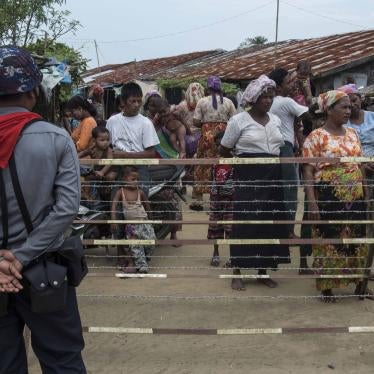(New York) – The protection and assistance needs of Rohingya who fled ethnic cleansing in Burma should be high on the agenda of world leaders at upcoming summits in Vietnam and the Philippines, Human Rights Watch said today as it released its “Ten Principles for Protecting Refugees and Internally Displaced People Arising from Burma’s Rohingya Crisis.”
Since late August 2017, more than 600,000 Rohingya refugees have fled to Bangladesh while hundreds of thousands of internally displaced people remain in Burma’s Rakhine State. Rohingya refugees have the right to return to their homes in Burma, but all returns must be voluntary and safe with full respect for returnees’ human rights. World leaders need to press Burma to end its abusive operations, prevent future atrocities, and create the conditions necessary for Rohingya to choose to return home in safety and dignity, Human Rights Watch said.
“The Rohingya crisis is of gargantuan proportions and needs to be treated with utmost urgency,” said Bill Frelick, refugee rights director at Human Rights Watch. “Leaders at the upcoming APEC and ASEAN summits should be putting the rights of the Rohingya at the top of their agenda.”
The “Ten Principles” are intended to guide governments and humanitarian agencies as they address the Rohingya refugee crisis. They include an urgent call on donor governments to provide generous support to meet the humanitarian needs of Rohingya refugees in Bangladesh and internally displaced people of all ethnicities remaining in Burma.
The Bangladeshi government should keep its border open to asylum seekers and not coerce returns, respecting the principle of nonrefoulment, which prohibits the return of refugees to places where they would be persecuted or face a real risk of torture, or cruel, inhuman or degrading treatment.
Many refugees have told Human Rights Watch that they want to return home, but none interviewed believe it’s safe now or will be for the foreseeable future.
Refugee camps in Bangladesh are not a sustainable solution, Human Rights Watch said. The Bangladeshi government and its humanitarian partners should regard refugee camps as a temporary fix during this crisis and should transition as soon as practically possible to accommodations that are conducive to free movement and that promote dignified self-sufficiency.
Bangladesh is constructing a large refugee camp in the Cox’s Bazar district of the country, which officials have said they plan to surround with barbed wire. Bangladeshi authorities have previously suggested that Rohingya refugees could be relocated from the Cox’s Bazar area to Thengar Char island, an uninhabited, undeveloped coastal island that is highly susceptible to flooding. Either situation would deprive refugees of their rights to freedom of movement, livelihood, food, and education, in violation of Bangladesh’s obligations under international human rights law.
“The Bangladeshi government has responded generously to the current crisis, keeping its borders open to Rohingya fleeing Burma,” Frelick said. “But close monitoring is needed to ensure that Bangladesh keeps its borders open to asylum seekers while respecting the rights of refugees to education, health, and work.”
The Burmese government has indicated that Rohingya who wish to return to the country should live in camps for internally displaced people. Camps for displaced people and “safe zones” in Burma are not an acceptable solution for returnees, Human Rights Watch said. Refugees and internally displaced people who were arbitrarily or unlawfully deprived of their former homes, lands, properties, or places of habitual residence have the right to return to their place of residence or choice, and the to the return of their property. Burma should respect the right of those who are unable or unwilling to return to their homes to choose compensation for the loss of their homes and properties.
As with the internment of Rohingya internally displaced people after the 2012 anti-Rohingya violence in Rakhine State, any such camps would invariably limit basic rights, segregate returning Rohingya refugees and internally displaced people from other Burmese, and exacerbate ethnic and religious discrimination. Such camps could become permanent, and act as a barrier for returning refugees and internally displaced people to reconstruct their homes, work their land, regain livelihoods, and reintegrate into Burmese society.
The Rohingya refugee population in Bangladesh consists not only of those who have fled the recent ethnic cleansing campaign, which Human Rights Watch has determined amounts to crimes against humanity, but also hundreds of thousands who have fled previous Burmese government repression and violence. In all, as many as one million Rohingya refugees may be in Bangladesh.
Exacerbating the Rohingya’s dire situation in Burma is the Burmese government’s effective denial of citizenship for Rohingya under the discriminatory 1982 Citizenship Law. This has facilitated enduring rights violations, including restrictions on movement; limitations on access to health care, livelihood, shelter, and education; and arbitrary arrests and detention.
“At every high-level meeting where this crisis is being discussed, leaders should call Rohingya refugees what they are: ‘Rohingya refugees,’” Frelick said. “Governments should not use euphemisms or otherwise mince words to suggest that these are not refugees deserving of all their rights as refugees or to deny their ethnic identity and nationality ties to Burma.”









